From emperor Otho’s Estate to Trappist Beer: The Layered History of Three Fountains Abbey
Rome, Italy
On the ancient Via Laurentina, on the outskirts of Rome, lies a small valley rich in springs, visited by pilgrims for about two thousand years: ad Aquas Salvias.
In Roman times, the wood Trium Fontium (Three Fountains) stood here ad Acquas Salvias, along with several buildings related to the cult of the Goddess Dia, including the Temple of the Mother Goddess where the three miraculous springs dedicated to her flowed. Tanks for water where ablutions and ceremonies took place were probably also present. This would explain the existence of three very close churches built on the remains of pagan temples within the wood.
According to some scholars, the valley derived its name from the family that owned its estate there in late Latin times, the gens Silvia. A family of Sabellic origin – since their nomen is a patronymic surname derived from the common Oscan praenomen Salvius - which probably spread throughout Italy long before obtaining Roman citizenship. We know that during the late Republic, the Salvii were a minor Roman plebeian family that rose to prominence at the beginning of the Empire when its most illustrious member, Marcus Otho, fiancé of Nero's sister Messalina, became emperor for 95 days in 69 AD; after 175 AD, they are no longer mentioned.
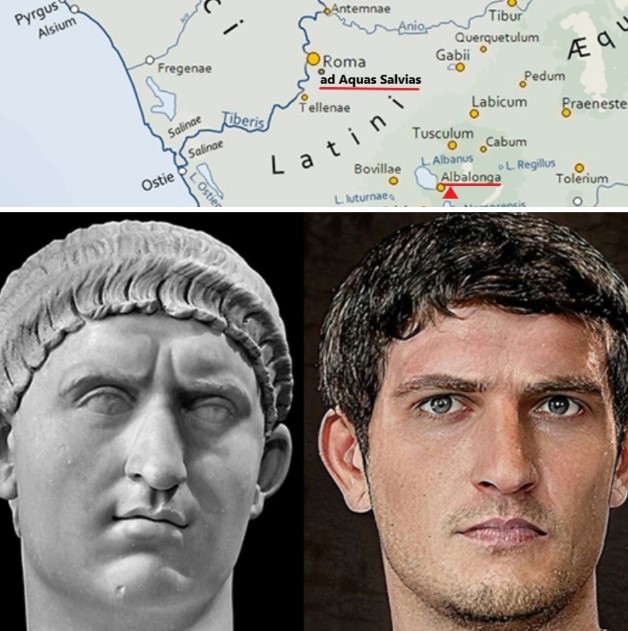
Map of ancient Latium highlighting the location of ad Aquas Salvias, and graphic reconstruction of the face of Marcus Salvius Otho by Haroun Binous.
According to legend, the Apostle Paul was beheaded ad Aquas Salvias on June 29, 67 AD. However, the story of his martyrdom is not recorded in the New Testament. We know from the Acts of the Apostles that he was held under custodia militaris (military custody), yet free to preach:
Paul stayed two full years in his own rented house, welcoming all who came to him, proclaiming the kingdom of God and teaching about the Lord Jesus Christ with all boldness and without hindrance
- Acts 28:30-31
Perhaps Paul's trial ended with his acquittal because none of his accusers appeared, or because he received an act of clemency from the Emperor. Afterwards, Paul travelled to Spain, fulfilling a long-held plan, then returned towards the regions of the Aegean Sea. However, in Nicopolis he was arrested. Brought back to Rome and subjected to a new trial, he was sentenced to death and finally executed.
The first official mention of the Apostle's death comes from a text written about thirty years after his execution. Clement I, the Bishop of Rome at the time, in a letter addressed to the Christian community in Corinth, recalls that the Apostle
because of jealousy and strife, after preaching justice to the whole world [...] endured martyrdom before the rulers
- 1 Clement 5:2
Other information concerning Paul's martyrdom, associated with Peter's, comes from an early Christian historian: Eusebius of Caesarea (265-340). Eusebius notes:
During the reign of Nero, Paul was beheaded right in Rome, and Peter was crucified there. The account is confirmed by the names of Peter and Paul, which are still preserved today on their tombs in that city
- Hist. eccl., 2,25,5
Apocryphal literature also addressed Paul's death. In the Acts of Paul (late 2nd century), it is stated that the Apostle's martyrdom occurred following his death sentence by beheading, decreed by Nero. The circumstances of the martyrdom are elaborated upon by Pseudo-Marcellus (5th century) in the Acts of Peter and Paul, where two miracles are said to have occurred at the Apostle's "beheading": milk flowing from the severed neck, and three springs gushing forth where his head bounced three times on the ground.
Regarding the place of burial, there is dual testimony. The first is from Gaius, a Roman presbyter of the 2nd century, who declares:
I can show you the trophies [= burial monuments] of the apostles: if you go to the Vatican or to the Ostian Way, you will find the trophies of the founders of the Church
- Hist. eccl. 2,25,6-7
The second comes from a writing by Pseudo-Abdias, the Passion of Paul, an apocryphal work from the 6th century, which states that the burial of the Apostle's mortal remains took place outside the city, at the second milestone on the Via Ostiense, on the estate of Lucina, a wealthy Roman Christian matron, upon whose house the current church of San Lorenzo in Lucina stands.
Opinions also differ concerning the date of the Apostle's death. For some, Paul died in 64, during the anti-Christian persecutions following the Great Fire of Rome; Eusebius of Caesarea and Saint Jerome placed it in 67, the fourteenth year of Nero's reign, while according to others, the Apostle's death occurred a few years earlier, between 56 and 58.
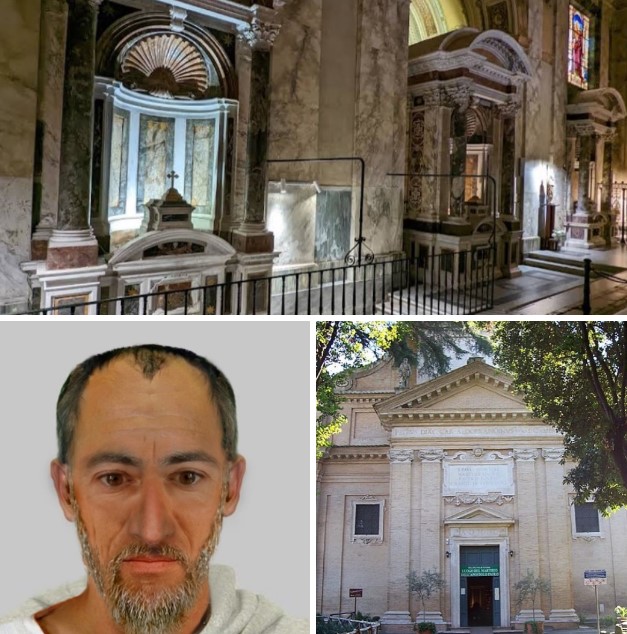
The three fountains inside the church of Saint Paul and his facial composite (* 7-10; † 64-67); created by experts of the Landeskriminalamt of North Rhine-Westphalia using historical sources, proposed by Düsseldorf historian Michael Hesemann
According to legend, Paul's head bounced three times before coming to rest on the ground, and at each spot it touched, a spring gushed forth: the first with hot water, the second warm, and the third cold. Hence the name of the place "Tre Fontane" (Three Fountains).
This is water of volcanic origin. The territory where it flows was subject to eruptive phenomena from the Alban Hills volcanic complex in prehistoric times. The mineral springs are the result of secondary phenomena of volcanic activity. These three small springs, although close together, have different temperatures. This is likely because there is a mixing of warm/cold mineralized waters from separate circuits, connected to local deformation and fracturing which can be linked more or less directly to the secondary activity of the Latial Volcano (Vulcano Laziale). Perhaps their formation can be attributed to the type of pyroclastic rocks traversed, the residence period of the waters underground, the different temperature values of the aquifers, and consequently, mixing between waters from different hydrodynamic and physico-chemical circuits.
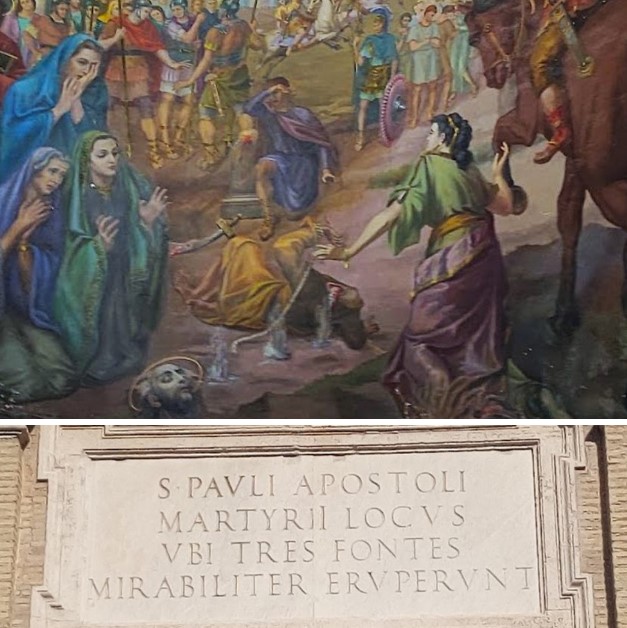
Church of San Paolo at the Three Fountains Abbey: painting depicting the beheading of Saint Paul and the large marble plaque on the architrave of the church facade which reads:
S.PAULI APOSTOLI MARTYRII LOCUS UBI TRES FONTES MIRABILITER ERUPERUNT
Site of the martyrdom of St. Paul the Apostle where three springs miraculously gushed forth.
According to other scholars, the locus ad Aquas Salvias derived its name from sage (salvia), a sacred herb with healing virtues that grew here in antiquity. The ancient Romans used sage (from the Latin salvus, meaning salvation, health) to cure every ailment, for example against snake bites, and to strengthen the body and memory.
Given its sacredness, they gathered it with a precise ritual during solemn ceremonies: without the use of iron objects, wearing a white tunic, barefoot and with well-washed feet. Being a sacred plant, it was certainly dedicated to a Goddess.
A legend connected Christians to sage: when the Holy Family fled to Egypt, only the humble sage plant agreed to hide the Baby Jesus from the soldiers' sight. The Virgin Mary then blessed it and gifted it with its therapeutic qualities.
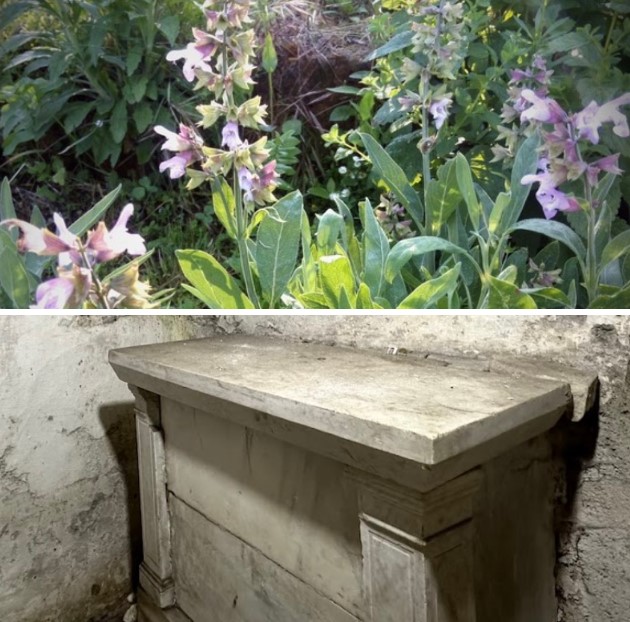
Pagan altar dedicated to the Goddess Dia in the Santa Maria Scala Coeli Church, found underground and later reused as the altar of St. Zeno. It appears that the altar's inscriptions were partially erased to dedicate it to Christian worship.
In 1867-68, archaeological excavations were conducted ad Aquas Salvias which attested to the existence of a Christian cemetery from the third century AD and a place of worship from the 4th-5th century AD, both linked to the memory of St. Paul's martyrdom. The discovery of a pagan altar dedicated to the Goddess Dia (a Roman deity of fertility and growth, whose cult was entrusted to the Fratres Arvales, created according to tradition by Romulus himself), suggests that this place had a vast wood where three springs dedicated to her, and therefore miraculous, flowed. It also suggests a connection to the ancient sanctuary of the Goddess Dia, located about 7 km away along the Tiber river on the ancient Via Campana, at the first boundary of Roman territory, the Ager Romanus Antiquus.
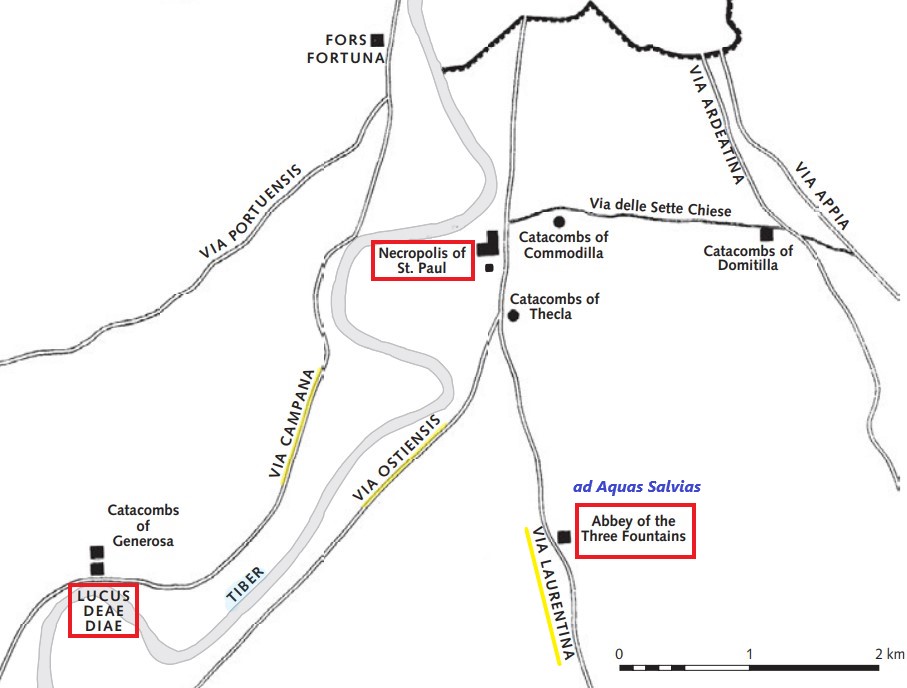
Western environs. Viae Aurelia, Campana, Ostiensis
Subsequently, Christianity reinterpreted the origin of the three springs, declaring that they had miraculously sprung forth through the agency of St. Paul, and transformed the Roman pagan religious buildings erected at the sites of the three springs into churches. Indeed, today an abbey complex called Tre Fontane stands here, housing three churches dedicated to Saints Vincent and Anastasius, to Santa Maria Scala Coeli, and to St. Paul.
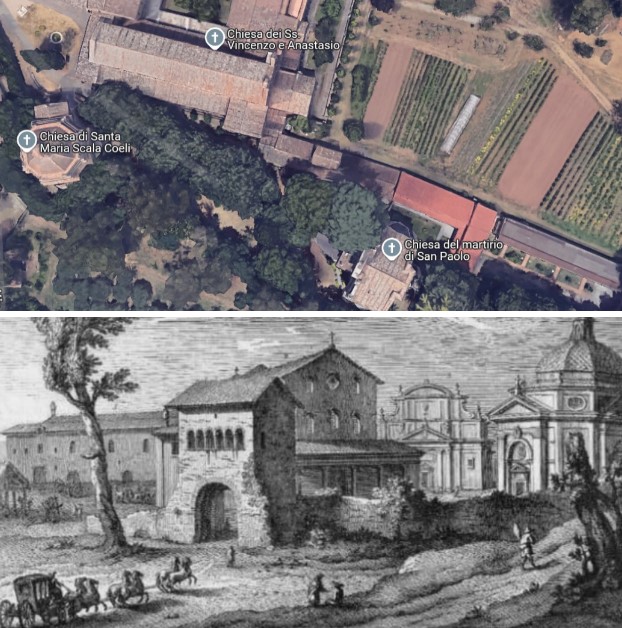
Complex of the Three Fountains Abbey and in 1753 by Giuseppe Vasi.
History of the Abbey of Tre Fontane
The property at ad Aquas Salvias was donated by Pope Gregory I, known as the Great (540-604), to the Basilica of St. Paul, where, according to tradition, Paul was buried.
Here arose the abbey church of Saints Vincent and Anastasius, and the late sixteenth-century churches of Santa Maria Scala Coeli and San Paolo.
Around 625, Pope Honorius I (585-638) founded a monastery initially run by Greek monks, who brought there the relic of the head of St. Anastasius. It flourished between the 8th and 9th centuries when it was fortified with walls and a turreted gate (Arch of Charlemagne).
At the end of the 11th century, with the rise of Cluniac power, the abbey and its possessions passed to them for a few decades. In the second half of the 11th century, Pope Gregory VII (1020-1085) donated the abbey to the Benedictines of St. Paul, but in 1140 Pope Innocent II (...-1143) assigned it to the Cistercians. They built the Abbey Church. It was the second Cistercian monastery founded in Italy after that of Chiaravalle in Milan. From then on, the complex was rebuilt according to the rules laid down by St. Bernard of Clairvaux (1090-1153), reaching completion in 1221.
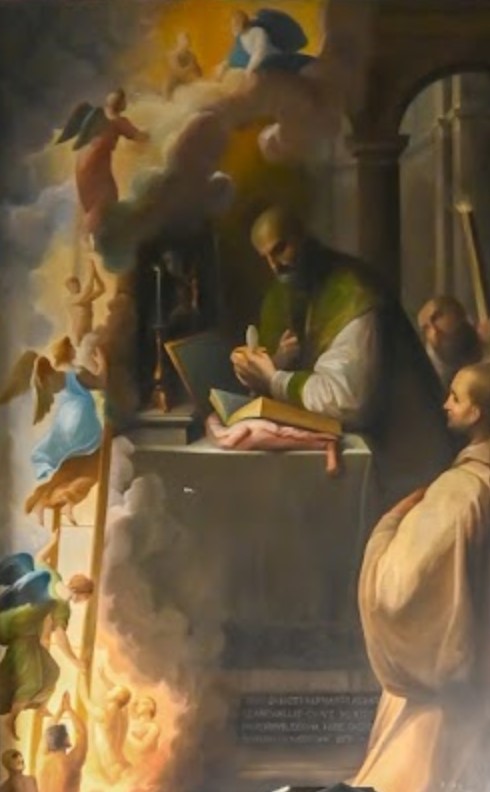
Saint Bernard, while celebrating Mass here, had a vision of a very long ladder leading to heaven. Souls were ascending this ladder, and the Madonna waited at the top to welcome them; this is where he had the vision of the Scala Coeli (Ladder to Heaven).
The last interventions were carried out in anticipation of the Jubilee Year of 1600 with the construction of the churches of S. Maria Scala Coeli and S. Paolo, but the unhealthiness of the area caused its decline, culminating in the Napoleonic suppression and consequent abandonment.
After many centuries and vicissitudes, in 1808 the Abbey was suppressed by the French, who dispersed its patrimony; only the library and archives were transferred to the Vatican. The valley of the Acquae Salviae, left to nature, became marshy and infested with malaria.
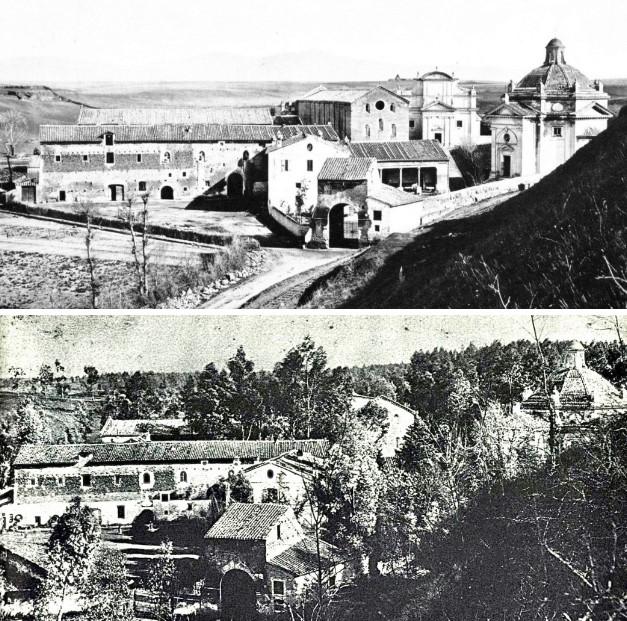
Three Fountains Abbey in 1870 and 1879, before and after the planting of eucalyptus trees.
The rebirth began in 1867, the eighteenth centenary of the martyrdom of Saints Peter and Paul, when Pius IX (1792-1878) provided for restorations. The following year, thanks to a French donation, a community of Trappist friars was settled in the ancient abbey under perpetual leasehold (enfiteusi perpetua). They carried out the restoration of the basilica and the reclamation of the 450-hectare estate, which had long been abandoned due to malaria. They carried out a general reclamation through canalization, the planting of eucalyptus trees (the first in Rome), and the filling in of a pond. Only a small part of this wood remains today, and a well-known liqueur is distilled from its trees.
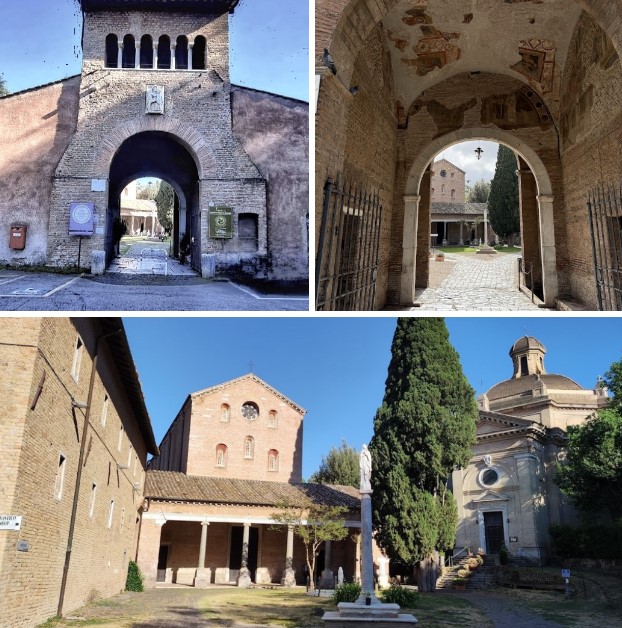
Charlemagne's Arch opens onto the garden of the abbey complex. To the left are the strictly monastic buildings with the cloister and the monastery; opposite, the church dedicated to Saints Vincent and Anastasius; to the right, the church of Santa Maria Scala Coeli. It is a double gate and was built in the 8th-9th century AD, probably on an oratory of St. John the Baptist. Inside the arch are partially damaged frescoes, depicting Charlemagne's donation (805 AD), which is the most visible and representative evidence of what allowed the millennial life of this sacred place. The events are depicted in successive panels, almost like a historical comic strip, following a traditional practice in medieval frescoes.
Since the 6th century AD, the area has been chosen as a residence by men of faith who have renounced comforts and earthly goods for the love of God. Of great importance is the Grotta delle Tre Fontane, now a sanctuary frequently visited by pilgrims, where an apparition of the Virgin Mary occurred on April 12, 1947. The Abbey is always open, and one can purchase products made by the Trappist friars, including beers produced on-site.
Abbey Church of Ss. Vincenzo and Anastasio
Past the Arch of Charlemagne, we find the church dedicated to Saints Vincent and Anastasius at the end of the square. It was founded by Honorius I in the 7th century AD to house the relics of St. Anastasius, and from the following century also those of St. Vincent.
We know that during this period, ownership of the Argentario promontory in Tuscany passed from the Roman basilica of Ss. Pietro e Marcellino to the abbey of Ss. Vincenzo e Anastasio alle Tre Fontane. At the origin of this transfer of property is placed a joint donation by Pope St. Leo III (795-816) and Emperor Charlemagne (774-815), consequent to a historical event. The nearby Tuscan city of Ansedonia was in the possession of the enemies of the emperor and the faith (infidels), but Charlemagne could not liberate it until a vision through an angel showed him the head of the martyr St. Anastasius (which was preserved at Tre Fontane) waging war against the enemies and defeating them, leading to the subsequent entry of imperial troops into the city. So the emperor, with the pope's help, sent for the head, and as soon as it arrived on the spot, an earthquake caused the walls to collapse, allowing the capture, and the enemies were killed. Therefore, the emperor, having taken possession of the fortress, granted it to the saint, and for him to the abbey. Subsequently, the abbey of Ss. Vincenzo e Anastasio was rebuilt with the monastery by the Cistercians, reusing existing buildings from the 10th and 11th centuries, and completed by Honorius III (1221). Today it still appears practically intact from the time of its construction.
The brick facade, with a double slope, is preceded by a portico with remains of 13th-century frescoes, with reused Ionic columns supporting an architrave and corner pilasters, whose proportions were altered by the addition of bases to lower the floor level during the 1868 restoration.
Inside, divided into three naves by pillars and round arches, the use of a slightly pointed barrel vault and austere monumentality are typical of early Cistercian architecture; apostles by the Raphael school are painted on the pillars, and near the altar, the 'Baptism of Christ' on the right and 'Noli me tangere' on the left.
To the left of the church are the monastic buildings:
• The cloister, the oldest surviving Cistercian one in Rome, original on the north and east sides, covered with cross vaults reinforced by transverse arches on pillars framing quadriforas with reused small columns;
• The Chapter House, in the center of the east side;
• The Refectory, on the north side.
In the monastery, frescoes detached from the dormitory and from a portico on the upper floor, including a 'Calendar of the Months', a rare example of 14th-century secular painting; in a room above the sacristy, a contemporary fresco with the 'Coronation of the Virgin'.
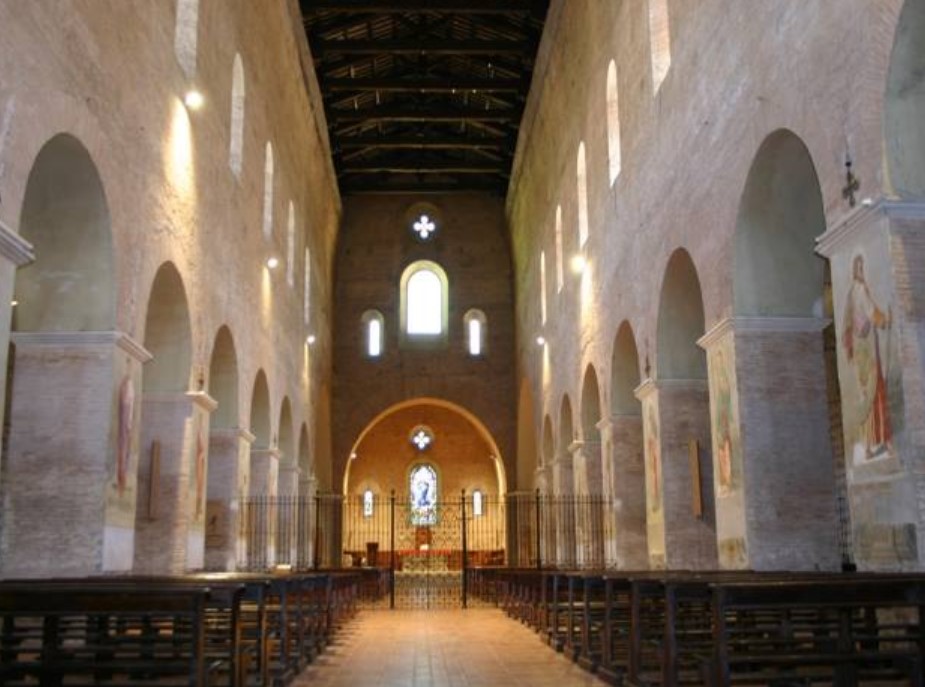
Interior of the abbey church of San Vincenzo and Sant'Anastasio.
Church of S. Maria Scala Coeli
The history of the site dates back to the mid-7th century when the presence of an “Abbot George of the monastery of Cilicia which stands at the Acquae Salvie of our city” is attested. The original nucleus of the complex, therefore, was the Greek-Armenian one, to whom the founding of the church now called Santa Maria Scala Coeli is attributed.
It is the smallest of the three churches present, along with the one dedicated to San Paolo, reached by crossing a short tree-lined avenue. It is located to the right of the abbey. It was built by Giacomo Della Porta for Cardinal Alessandro Farnese (1581-84) on the site where, under Diocletian, St. Zeno and his 10,203 companions are said to have suffered martyrdom, and where a church dedicated to Mary already existed in the 7th century (the underlying commemorative chapel of St. Bernard's dream dates back to 1138).
The building, set on a rise in the ground, has a facade surmounted by a pediment on a single order of Doric pilasters. Inside, the 16th-century environment, octagonal in plan and covered by a dome, is articulated by corner Corinthian pilasters. In the apse on the left are the fresco 'Saints with Clement VIII and his nephew Pietro Aldobrandini' and the mosaic by Francesco Zucchi based on a design by Giovanni De Vecchi.
From the stairs on the left, one accesses the crypt which preserves a Renaissance altar incorporating Cosmatesque elements; at the rear are two small rooms, perhaps the tomb of the martyrs.
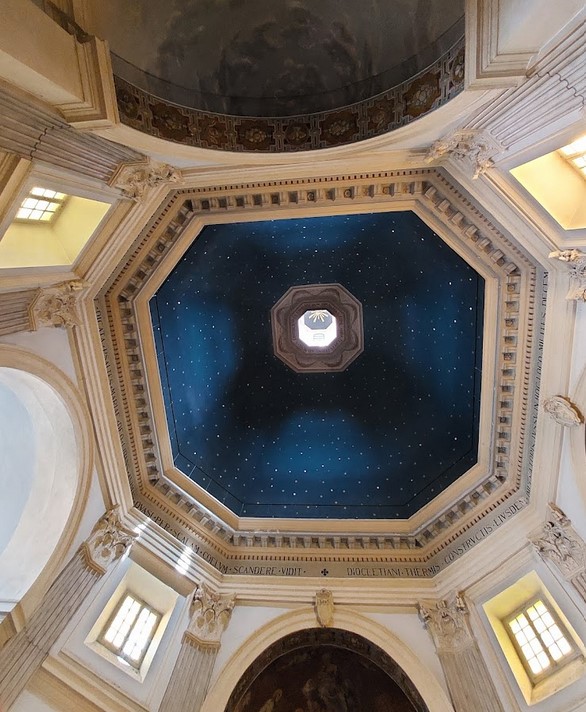
Octagonal dome of Santa Maria Scala Coeli.
Church of San Paolo
This is the church dedicated to the martyrdom of St. Paul and is the most sacred place of the highest historical and spiritual importance in the Abbey of Tre Fontane.
It is located at the end of the avenue (remains of a branch of the ancient Via Laurentina) that starts to the right of the church of Ss. Vincenzo e Anastasio. It was built in the 5th century on the site where the apostle is believed to have suffered martyrdom.
It owes its current appearance to Cardinal Pietro Aldobrandini, who had it rebuilt by Della Porta in 1599-1601. During the restorations under Pius IX, the paving of the primitive building dating back to the 6th-7th century AD was found under the church, laid on three levels.
The architecture of the complex reproduces a plan composed of a vestibule and a transverse nave: onto the volume of the nave, whose facade is surmounted by a curved pediment and lateral volutes, is grafted that of the atrium, consisting of a small temple with a pediment.
From the vestibule, one enters the spacious interior, with frescoes by Emilio Lazzari, featuring two apsed chapels at the ends and an apse in the center; on the floor, a polychrome Roman mosaic with personifications of the Four Seasons, from Ostia Antica; in the right corner, a grate protects the column to which St. Paul is said to have been tied during his martyrdom; on the left, the fresco 'Crucifixion of St. Peter', an ancient copy after Guido Reni, is visible; along the back wall and in the apse are arranged, on three levels, the fountains designed by Della Porta. Three aedicules in the form of niches, commemorating the miracle of St. Paul, are placed above the three small water springs.
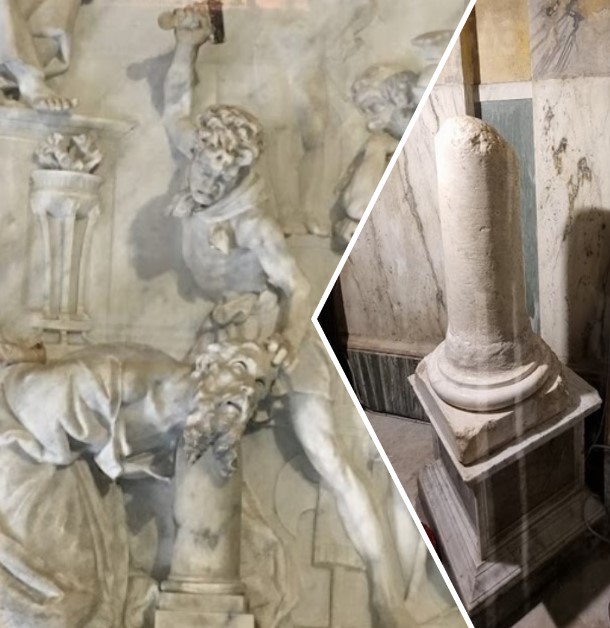
Bas-relief inside the Church of San Paolo alle Tre Fontane depicting the beheading of the apostle, located behind the niche of the central spring, on the apse wall. The white marble column which tradition holds Saint Paul was tied to for his martyrdom, located in the right-hand corner of the Church.
These three small water springs, although close together, have different temperatures, probably due to a mixing of mineralized hot/cold waters from different circuits connected to local deformation and fracturing, more or less directly linked to the secondary activity of the nearby Laziale Volcano. Perhaps their formation is attributable to the type of pyroclastic rocks they pass through, the different aquifer temperatures during the water's subsurface residence time, and thus mixing between waters from different hydrodynamic and physico-chemical circuits.
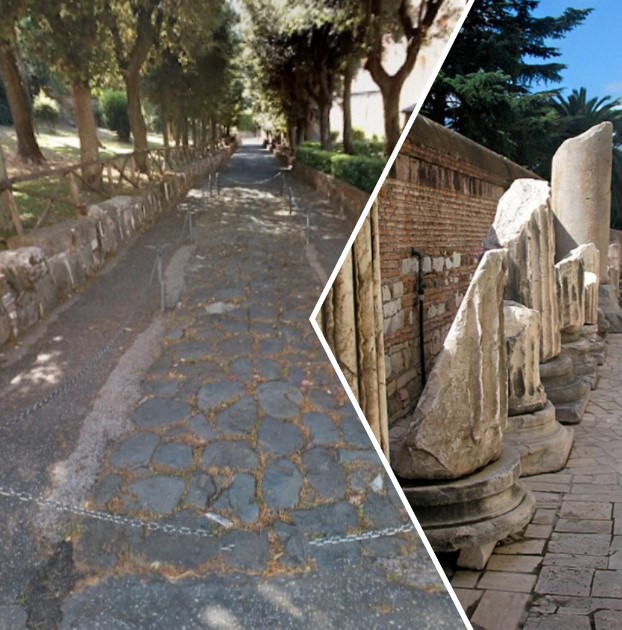
Roman basalt pavement (basolato) of the sanctuary of the Goddess Dia, remains of her temple (1st century AD).
It is possible to hear the flowing of the waters by approaching the base of the aedicules in the Church of San Paolo, exactly as the multitude of faithful who, in silence, have venerated this mystical place and the three spring water sources over the centuries.
Rome, Via di Acque Salvie, 1
Email: info@abbaziatrefontane.it
